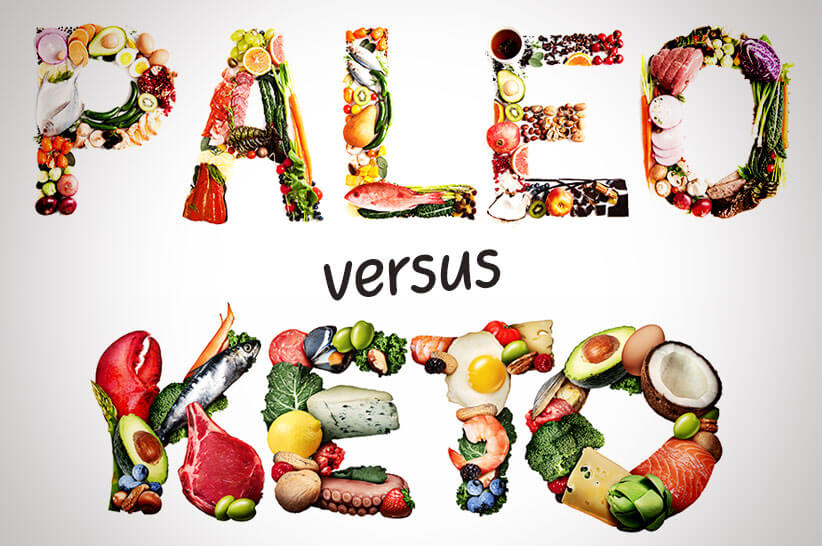The Ketogenic and Paleogenic diets are now among the most popular diets available. They have certain parallels, but there are also significant variances in the foods that are permitted, their impact on the body, and the important health implications. But what are these diets?
Today, we will see the major differences between Paleo Vs Keto, and we will also learn which one is better for effective weight loss!
What is Paleo Diet?
A Paleolithic diet is a dietary plan that emphasizes foods that people consumed throughout the Paleolithic period of human evolution. The caveman diet, also known as the Stone Age diet, it is a way of eating that dates back to the Stone Age. The goal of this diet is to avoid goods that are produced by current food processing and agricultural practices.
Following the paleo diet means choosing foods that would have been available for hunting or gathering in Stone Age times, and then eating them. According to the natural resources available in their area, the diet of a Stone Age individual would have varied. Some individuals feel that the human body is not well-suited to modern-day foods because of its evolutionary history.
According to proponents of the diet, eliminating items like dairy, grains, and legumes may aid in weight loss as well as the prevention of heart disease and type 2 diabetes in certain people. Among the things that are prohibited on a paleo diet are highly processed foods as well as legumes, grains, and dairy products.
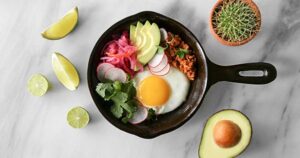
Additionally, the paleo diet advocates the use of nutritious fats from sources such as wild or grass-fed animals, nut oils, butter, olive oil, and avocados, among other sources. People should consume larger quantities of animal protein, according to the guidelines. It has been suggested that the paleo diet may be beneficial for those suffering from metabolic syndrome and for those looking to lower their cholesterol.
Scientists, on the other hand, must do more studies to validate this. The paleo diet is a way of eating that emphasizes natural foods while excluding grains, legumes, and the majority of processed foods to promote health and fitness. In addition to the food, there is a lifestyle component that emphasizes health habits and physical activity.
What Is Keto Diet?
A keto diet is a kind of eating plan that emphasizes the consumption of large amounts of healthy fat, moderate amounts of protein, and very few carbs. Carbohydrates are normally used by the body as a source of energy. When a person does not consume enough carbohydrates, the body begins to deplete its fat and certain protein reserves.
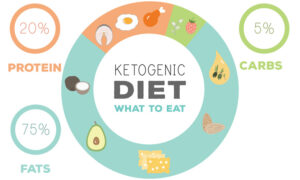
True ketosis occurs when the liver converts stored fat into ketones, which are subsequently used by the body for energy production. The ketogenic diet is designed to help you achieve this state of ketosis. Some feel that entering a state of ketosis is an effective strategy to eliminate extra fat and minimize the chance of developing health issues such as heart disease and diabetes.
Specific foods are encouraged and excluded from the ketogenic diet. If you are on a ketogenic diet, you cannot acquire your carbs from grains or legumes. Their carbohydrates must originate from a keto-friendly vegetable, such as leafy greens, or from a select set of fruits, predominantly berries, to be considered keto-friendly.
- 70–80% of calories come from fat.
- Protein accounts for 20–25% of total calories.
- Carbohydrates account for 5–10% of total calories.
Similarities Between Paleo Vs Keto:
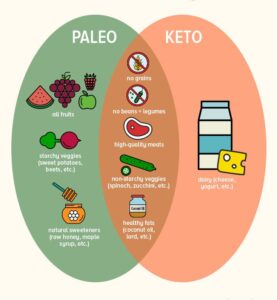
1. Emphasizes On Whole Food
Fundamentally, both the paleo and ketogenic diets are designed to depend on whole-food sources of nutrients as their primary sources of energy. The term “whole food” refers to a meal that has undergone just the very minimum amount of preparation before reaching your plate.
Both the ketogenic and paleogenic diets aggressively advocate for the elimination of all ultra-processed foods and the substitution of whole foods such as fresh vegetables, meat, fish, nuts, and seeds. Both the paleo and ketogenic “rule books” make it clear that processed fats, oils, and sweets are not allowed, and this is particularly true.
2. Removes Grains & Legumes
Both the paleo and ketogenic diets, albeit for different reasons, severely oppose the use of grains and legumes. Grains and legumes were likely not part of early human diets, according to the paleo community, and they contain antinutrients, thus they were eliminated from the diet.
Antinutrients are substances present in certain plant-based diets, such as lectins and phytates, that are harmful to the body. When consumed in excessive numbers, they may impair your body’s capacity to absorb minerals and nutrients, and they can also induce stomach discomfort when consumed in little amounts.
Research, on the other hand, shows that consuming foods containing these chemicals may have other health advantages as well. The keto diet also excludes grains and the majority of legumes, however, this is due to the high carbohydrate content of these foods. Grains and legumes provide a considerable quantity of carbohydrates to the diet. If you consume them while following a ketogenic diet, you run the risk of causing your body to exit ketosis.
3. Removes Added Sugar
The ketogenic and Paleogenic diets both severely restrict the use of added sugars. This mostly comes under the same concept of avoiding highly processed foods in general, which is a feature of both diet programs. Paleo dieters, on the other hand, have a little more wiggle room with this restriction since unrefined sugar sources such as honey and maple syrup are still acceptable. Given the high carbohydrate content of these items, keto does not allow for the use of additional sugar sources, whether they are refined or not.
Read Here: Best Pregnancy Pillow In 2021 For Mothercare
4. Emphasizes On Healthy Fats
Both the paleo and ketogenic diets advocate the use of unprocessed, healthful fats, which is consistent with their common aim of promoting maximum health. Both diets also encourage consuming moderate-to-liberal quantities of chosen refined oils, such as olive and avocado oils, as well as nuts, seeds, and fish, according to their respective guidelines.
Because of their high polyunsaturated and monounsaturated fat content, these foods are well-known for their heart-healthy properties. Both diets also restrict the use of highly processed fats, such as trans fats, which are harmful to one’s health when ingested in large quantities regularly.
The Keto diet focuses a strong emphasis on fat in general since fat is considered to be the foundation of the whole diet. While Paleo is not strictly a high-fat diet, it does adhere to this suggestion to promote general health.
5. Both May Reduce Weight!
One of the most prominent reasons for the popularity of the keto and paleo diets is the belief that they would help people lose weight. However, this is not always the case. Unluckily, there is only a limited amount of data available to determine how beneficial these diets are for long-term, maintained weight reduction.
Some short-term studies, on the other hand, seem to be encouraging. According to small research on postmenopausal, obese women who followed a paleo diet for six months, lost 9 percent of their body weight and 10.6 percent of their body weight after 12 months At the 24-month milestone, there was no further statistically significant weight change.
Several studies on low-carbohydrate, high-fat (LCHF) diets, such as the ketogenic diet, found that switching to this way of eating may result in short-term weight reduction in certain people. It’s possible that this was because a high fat intake normally results in a decrease in hunger and a reduction in the total number of calories ingested.
In addition, the process of ketosis may be leading to more effective removal of the body’s fat reserves from the body. The actual cause for this is still out in the air. Further investigation will be required to establish a definite causal link.
What is The Difference Between Paleo & Keto?
Now we will discuss the major difference between Keto and Paleo diets:
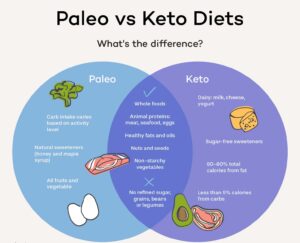
1. Paleo Vs Keto: Processed Meat
The very first difference between Keto and Paleo is the use of processed meat. When following a paleo diet, it is common to avoid processed meats such as bacon, salami, and ham, since they are the consequence of contemporary food processing processes and should be avoided.
Some individuals feel that minimally processed bacon that is free of nitrates and preservatives is appropriate for the Paleo Diet, while others say that this is not the case. It is OK to consume various kinds of meat on the ketogenic diet as long as they do not include sugar or carbs, which might interfere with the body’s capacity to achieve ketosis.
Some processed meats, such as bacon or sausage, may include sugar, so it’s important to check the labels carefully before consuming them. Given that processed meats may raise the risk of cancer and other health problems, persons on any diet may want to concentrate on eating high-quality meats rather than processed ones, according to the latest study.
2. Paleo Vs Keto: Use Of Sugar
The second major difference between the Paleo diet vs Keto diet is the use of sugar in both diets. Sweeteners considered “natural,” such as honey and maple syrup, are permitted on the paleo diet. Because they are a consequence of contemporary technology, artificial sweeteners such as sugar alcohols are not permitted, according to the regulations.
When it comes to artificial sweeteners, as long as they don’t include any sugar, the keto diet is OK (some products contain both sugar and artificial sweeteners). As a rule of thumb, people should choose sweeteners that do not induce increases in blood sugar levels, such as stevia and sucralose.
To follow the ketogenic diet, you cannot consume honey, maple syrup, or any other items that contain natural sugar or fructose.
3. Paleo Vs Keto: Starchy Veggies
Now we will learn how starchy veggies fit in the Paleo vs Keto diet. Some of the most nutrient-dense plants also contain a significant amount of starch or carbohydrate. These “starchy veggies” are not permitted on the ketogenic diet because they have the potential to disrupt ketosis and lead a person to ingest more carbs than they are permitted to consume.
The paleo diet, on the other hand, allows for the consumption of many of these beneficial veggies in moderation. A person following the paleo diet may consume foods such as sweet potatoes, beets, and carrots in moderation, but they should emphasize veggies that are low in carbohydrates such as broccoli, cauliflower, and spinach.
4. Paleo Vs Keto: Use Of Fruits
One major difference between Paleo and Keto diets is how both of them make use of fruits. Fruits include a variety of nutrients, vitamins, minerals, fiber, and antioxidants, and are generally considered to be a healthy food option for the vast majority of individuals. Fruits, on the other hand, include naturally occurring sugar, and certain fruits have much greater quantities of sugar and carbs than others.
A person following a paleo diet may consume whatever fruit they like, including fresh, dried, and frozen, but they should try to stick to the lower sugar varieties in particular. A paleo diet contains a lot of berries, citrus fruits, and melons, among other ingredients. Sugarier fruits, such as bananas, grapes, mangos, and cherries, may be included in the diet, but they should be consumed in moderation.
When it comes to fruit, the keto diet is more restrictive. It suggests that to maintain a state of ketosis in the body, a person should consume only low-sugar fruits in moderation. While berries are a frequent keto-friendly fruit, people may also consume limited quantities of other fruits such as cranberries, peaches, apricots, apples, and plums if they follow a strict diet.
5. Paleo Vs Keto: Dairy Products
The use of dairy products is a little confusing in the Paleo Keto diet. Because Paleolithic individuals did not eat dairy products, the paleo diet removes all dairy items from one’s diet. A person following the paleo diet is not permitted to eat cheese, milk, cream, or any other dairy products. People following the paleo diet, on the other hand, may consume unsweetened almond milk, coconut milk, and similar alternatives that do not include artificial sweeteners or thickeners.
Some dairy products are permitted on the ketogenic diet, particularly those that are heavy in fat and protein. In this way, the individual can consume the appropriate levels of these nutrients. It is prohibited to consume any dairy products that include sugar, such as ice cream, chocolate milk, or sugar-sweetened coffee creamer when following the ketogenic eating plan.
Those who eat dairy products that include artificial sweeteners in moderation, on the other hand, should exercise caution.
These were the major differences between the Keto diet vs Paleo.
Side Effects Of Keto vs Paleo Diet:
To prevent nutritional deficits, those who follow any diet that removes food categories should be certain that they are achieving their daily dietary needs. Anyone contemplating making a significant and unexpected change to their dietary habits should consult with their healthcare physician before proceeding.
Those who suffer from chronic health disorders such as heart disease, diabetes, or high blood pressure should pay particular attention to this point of advice. Those who follow the ketogenic diet may encounter adverse effects as a result of entering a state of ketosis. Keto breath, a keto skin rash, and the “keto flu” are all possible side effects.
Headaches, lethargy, nausea, mental sluggishness, insomnia, impaired exercise performance, constipation, and low libido are some of the symptoms associated with the keto flu. It is potentially dangerous to remain in a state of ketosis for a lengthy amount of time.
People who follow a paleo diet do not suffer these symptoms because paleo diets do not cause the body to enter a state of ketosis. Several nutritional supplements may assist individuals who are following the ketogenic diet is getting adequate nutrients, alleviating adverse effects, and meeting their daily macronutrient requirements.
One article advises those who follow the Paleo Ketogenic diet to make sure they are receiving enough calcium since the diet does not allow for the use of dairy products. Because of the rigorous limitation on carbohydrate-containing foods, the ketogenic diet is deficient in fiber and other minerals.
Now, let’s see which one is better the Paleo diet vs the Keto diet.
Read Here: Best Indian Couples Who Redefine Relationship Goals
Keto Vs Paleo For Weight Loss: Which One Is Better?

The ketogenic diet is successful in children with epilepsy, and a new study suggests that it may be beneficial for a variety of other neurological problems as well. Outcomes are observed immediately in the near term, as is the case with most weight-loss regimens, but it is unclear how long people will be able to maintain their weight-loss efforts and hence continue to experience positive results.
However, one of the less-healthy parts of the diet is the entire exclusion of legumes and grains, even though several studies have shown the health advantages of consuming this high-fiber, plant-based food categories. In addition to being difficult to maintain, restrictive eating choices are often unhealthy.
Final Words On Paleo vs Keto:
Followers of the paleo diet strive to eat like that of our ancient forefathers. They seek whole, unadulterated meals and steer clear of processed foods, grains, legumes, and dairy products, among other things. Paleo supporters contend that our bodies are incapable of processing foods that have developed since the invention of agriculture.
An initial paleo diet plan may assist with weight loss, insulin sensitivity improvement, and blood pressure reduction in the near run. Some of these health consequences seem to be supported by the findings of small, preliminary studies, but further study is needed to confirm them.
Because the paleo diet may not be suitable for everyone, it is recommended that you consult with a doctor or dietician before making any substantial dietary modifications. The 7-day meal plan provided above is a fantastic starting point for anyone interested in attempting the paleo diet.
